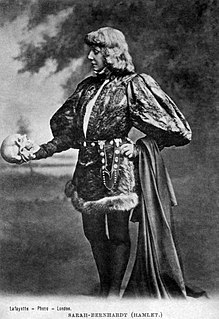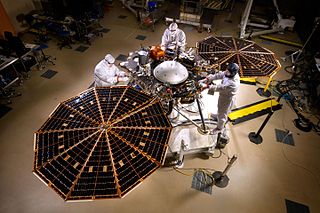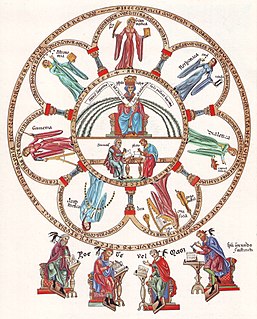
Liberal arts education can claim to be the oldest programme of higher education in Western history. It has its origin in the attempt to discover first principles – 'those universal principles which are the condition of the possibility of the existence of anything and everything'. The liberal arts, also known as the seven liberal arts, are those subjects or skills that in classical antiquity were considered essential for a free person to know in order to take an active part in civic life, something that included participating in public debate, defending oneself in court, serving on juries, and most importantly, military service. Grammar, logic, and rhetoric were the core liberal arts, while arithmetic, geometry, the theory of music, and astronomy were the following stage of education.

In the history of Europe, the Middle Ages lasted from the 5th to the 15th century. It began with the fall of the Western Roman Empire and merged into the Renaissance and the Age of Discovery. The Middle Ages is the middle period of the three traditional divisions of Western history: classical antiquity, the medieval period, and the modern period. The medieval period is itself subdivided into the Early, High, and Late Middle Ages.

The quadrivium is the four subjects, or arts, taught after teaching the trivium. The word is Latin, meaning four ways, and its use for the four subjects has been attributed to Boethius or Cassiodorus in the 6th century. Together, the trivium and the quadrivium comprised the seven liberal arts, as distinguished from the practical arts.
The trivium is the lower division of the seven liberal arts and comprises grammar, dialectic, and rhetoric.
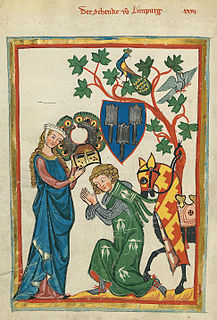
Chivalry, or the chivalric code, is an informal, varying code of conduct developed between 1170 and 1220, but never decided on or summarized in a single document. It was associated with the medieval Christian institution of knighthood; knights' and gentlewomen's behaviours were governed by chivalrous social codes. The ideals of chivalry were popularized in medieval literature, especially the Matter of Britain and Matter of France, the former based on Geoffrey of Monmouth's Historia Regum Britanniae, written in the 1130s, which introduced the legend of King Arthur. All of these were taken as historically accurate until the beginnings of modern scholarship in the 19th century.

Classicism, in the arts, refers generally to a high regard for a classical period, classical antiquity in the Western tradition, as setting standards for taste which the classicists seek to emulate. The art of classicism typically seeks to be formal and restrained: of the Discobolus Sir Kenneth Clark observed, "if we object to his restraint and compression we are simply objecting to the classicism of classic art. A violent emphasis or a sudden acceleration of rhythmic movement would have destroyed those qualities of balance and completeness through which it retained until the present century its position of authority in the restricted repertoire of visual images." Classicism, as Clark noted, implies a canon of widely accepted ideal forms, whether in the Western canon that he was examining in The Nude (1956), or the literary Chinese classics or Chinese art, where the revival of classic styles is also a recurring feature.
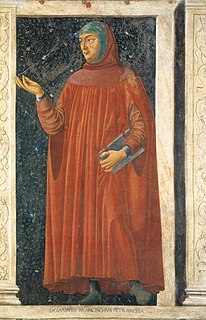
The "Dark Ages" is a historical periodization traditionally referring to the Middle Ages, that asserts that a demographic, cultural, and economic deterioration occurred in Western Europe following the decline of the Roman Empire.

Vitreous enamel, also called porcelain enamel, is a material made by fusing powdered glass to a substrate by firing, usually between 750 and 850 °C. The powder melts, flows, and then hardens to a smooth, durable vitreous coating. The word comes from the Latin vitreum, meaning "glassy".

The medieval art of the Western world covers a vast scope of time and place, over 1000 years of art in Europe, and at times the Middle East and North Africa. It includes major art movements and periods, national and regional art, genres, revivals, the artists' crafts, and the artists themselves.
Martianus Minneus Felix Capella was a Latin prose writer of Late Antiquity, one of the earliest developers of the system of the seven liberal arts that structured early medieval education. His single encyclopedic work, De nuptiis Philologiae et Mercurii is an elaborate didactic allegory written in a mixture of prose and elaborately allusive verse.

Late Latin is the scholarly name for the written Latin of late antiquity. English dictionary definitions of Late Latin date this period from the 3rd to the 6th centuries AD, and continuing into the 7th century in the Iberian Peninsula. This somewhat ambiguously defined version of Latin was used between the eras of Classical Latin and Medieval Latin. There is no scholarly consensus about exactly when Classical Latin should end or Medieval Latin should begin. However, Late Latin is characterized by an identifiable style.
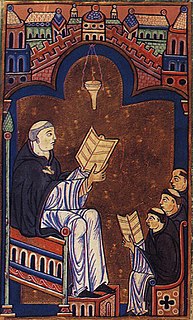
Hugh of Saint Victor, C.R.S.A., was a Saxon canon regular and a leading theologian and writer on mystical theology.

Allegory in the Middle Ages was a vital element in the synthesis of biblical and classical traditions into what would become recognizable as medieval culture. People of the Middle Ages consciously drew from the cultural legacies of the ancient world in shaping their institutions and ideas, and so allegory in medieval literature and medieval art was a prime mover for the synthesis and transformational continuity between the ancient world and the "new" Christian world.

The Late Middle Ages or Late Medieval Period was the period of European history lasting from 1250 to 1500 AD. The Late Middle Ages followed the High Middle Ages and preceded the onset of the early modern period.
A liberal education is a system or course of education suitable for the cultivation of a free human being. It is based on the medieval concept of the liberal arts or, more commonly now, the liberalism of the Age of Enlightenment. It has been described as "a philosophy of education that empowers individuals with broad knowledge and transferable skills, and a stronger sense of values, ethics, and civic engagement ... characterised by challenging encounters with important issues, and more a way of studying than a specific course or field of study" by the Association of American Colleges and Universities. Usually global and pluralistic in scope, it can include a general education curriculum which provides broad exposure to multiple disciplines and learning strategies in addition to in-depth study in at least one academic area.
James Westfall Thompson (1869–1941) was an American historian specializing in the history of medieval and early modern Europe, particularly of the Holy Roman Empire and France. He also made noteworthy contributions to the history of literacy, libraries and the book trade in the Middle Ages.
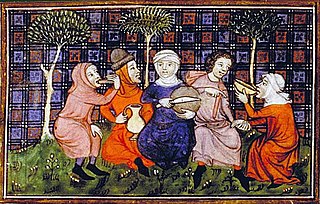
Medieval cuisine includes foods, eating habits, and cooking methods of various European cultures during the Middle Ages, which lasted from the fifth to the fifteenth century. During this period, diets and cooking changed less than they did in the early modern period that followed, when those changes helped lay the foundations for modern European cuisine. Cereals remained the most important staple during the early Middle Ages as rice was introduced late, and the potato was only introduced in 1536, with a much later date for widespread consumption. Barley, oat and rye were eaten by the poor. Wheat was for the governing classes. These were consumed as bread, porridge, gruel and pasta by all of society's members. Fava beans and vegetables were important supplements to the cereal-based diet of the lower orders.
Renaissance humanism saw a resurgence in hermeticism and Neo-Platonic varieties of ceremonial magic.

During the high medieval period, the Islamic world was at its cultural peak, supplying information and ideas to Europe, via Andalusia, Sicily and the Crusader kingdoms in the Levant. These included Latin translations of the Greek Classics and of Arabic texts in astronomy, mathematics, science, and medicine. Other contributions included technological and scientific innovations via the Silk Road, including Chinese inventions such as paper and gunpowder.
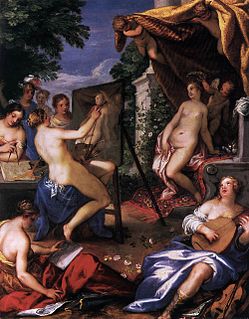
The arts refers to the theory and physical expression of creativity found in human societies and cultures. Major constituents of the arts include literature, performing arts, and visual arts.






